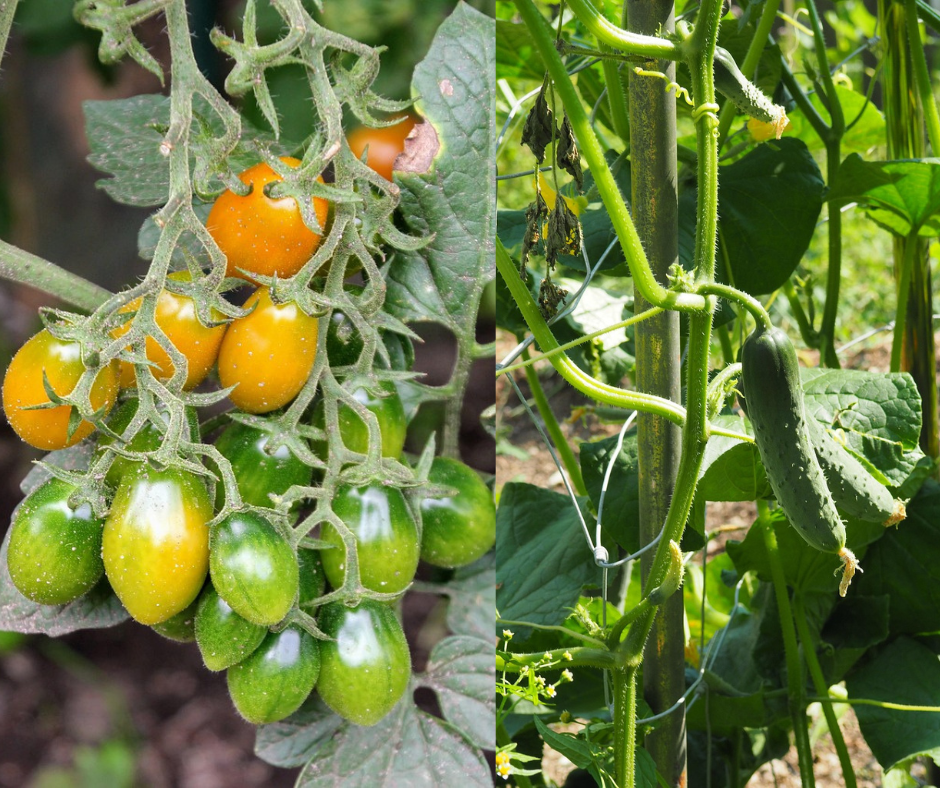
Today, we’ll delve into the intriguing question of whether cucumbers and tomatoes, two popular garden staples, can peacefully coexist side by side. As we explore this topic, we’ll uncover the secrets to their compatibility, the potential pitfalls, and the creative solutions that can help these two plants thrive together.
The Garden’s Dynamic Duo: Cucumbers and Tomatoes
The good news, aspiring veggie whisperers, is that cucumbers and tomatoes can, in fact, be happy neighbors! Both thrive in similar conditions, sharing a love for warm temperatures, full sun, and well-draining soil. This shared preference simplifies your life, allowing you to create a single “happy place” in your garden instead of juggling different soil mixes and light requirements.
However, like any good neighbors, boundaries are crucial. Planting them too close can lead to a competition for resources, like sunlight, water, and nutrients. This translates to stunted growth, fewer fruits, and potentially, a grumpy gardener (that’s you!).
The Benefits of Planting Cucumbers and Tomatoes Together
- Space-saving: Planting tomatoes and cucumbers together allows you to paint a richer picture without sacrificing space. Their similar sun and soil requirements eliminate the need for separate beds with different conditions. Think “vertical layering” – tomatoes climb trellises or cages, shading the ground while cucumbers sprawl beneath, maximizing every inch of your garden real estate.
- Shade: Cucumbers, like delicate ballerinas, prefer the cool shade of a stage. Enter the towering tomato plants, acting as natural parasols. During midday sun, the tomato leaves filter the intense rays, creating a microclimate perfect for cucumber vines to flourish without suffering sunburn. This dance of leaves not only protects the cucumbers but also conserves water, reducing evaporation from the shaded soil.
- Pollination: Planting tomatoes and cucumbers side-by-side creates a veritable feast for pollinators like bees and butterflies. Both plants boast fragrant flowers rich in nectar, attracting these essential guests to your garden party. As the pollinators flit between blooms, they inadvertently transfer pollen, leading to better fruit set for both tomatoes and cucumbers – a win-win for
The Potential Drawbacks of Co-planting Cucumbers and Tomatoes
- Nutrient competition: Both cucumbers and tomatoes are heavy feeders, and their close proximity can lead to nutrient competition, potentially stunting the growth of one or both plants.
- Disease transmission: Tomatoes are susceptible to certain diseases, such as early blight and late blight, which can be transmitted to cucumbers if they are planted too close together.
- Root interference: Cucumbers and tomatoes have different root systems, and their close proximity can lead to root interference, which can stunt the growth of both plants.
Strategies for Successful Co-planting
- Rotate crops: Rotating cucumbers and tomatoes in your garden can help prevent nutrient depletion and disease transmission.
- Plant in raised beds: Raised beds can help improve drainage and aeration, which can help prevent root interference and nutrient competition.
- Use companion plants: Planting certain companion plants, such as marigolds, can help deter pests and improve soil health, which can benefit both cucumbers and tomatoes.
- Monitor for disease: Regularly inspect your plants for signs of disease, and remove any infected plants to prevent the spread of disease to other plants.
Alternative Planting Options
- Plant in separate beds: If you’re concerned about the potential drawbacks of co-planting cucumbers and tomatoes, consider planting them in separate beds.
- Plant in succession: Plant cucumbers and tomatoes at different times to help prevent nutrient competition and disease transmission.
- Plant in containers: Planting cucumbers and tomatoes in separate containers can help prevent root interference and nutrient competition.
Cucumbers and tomatoes are two popular garden plants that can be planted together, but their close proximity can also lead to potential drawbacks. By understanding the benefits and drawbacks of co-planting these two plants, gardeners can make informed decisions about how to best utilize their garden space. Whether you choose to plant cucumbers and tomatoes together or in separate beds, the key to success is to monitor your plants for signs of disease and nutrient competition, and to use creative strategies to help them thrive
